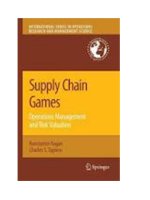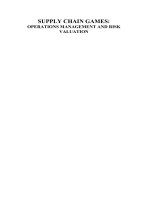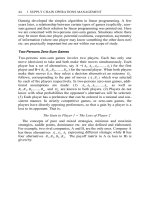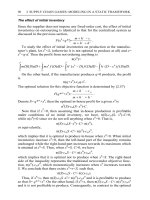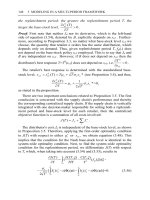Advanced operations management 2e david loader
Bạn đang xem bản rút gọn của tài liệu. Xem và tải ngay bản đầy đủ của tài liệu tại đây (4.25 MB, 354 trang )
ADVANCED
OPERATIONS
MANAGEMENT
Second Edition
David Loader
ADVANCED
OPERATIONS
MANAGEMENT
Second Edition
The Securities & Investment Institute
Mission Statement:
To set standards of professional excellence and
integrity for the investment and securities
industry, providing qualifications and promoting
the highest level of competence to our members,
other individuals and firms.
The Securities and Investment Institute is the UK’s leading professional and membership body for practitioners
in the securities and investment industry, with more
than 16,000 members with an increasing number working outside the UK. It is also the major examining body
for the industry, with a full range of qualifications
aimed at people entering and working in it. More than
30,000 examinations are taken annually in more than
30 countries.
You can contact us through our website www.sii.org.uk
Our membership believes that keeping up to date is
central to professional development. We are delighted to
endorse the Wiley/SII publishing partnership and recommend this series of books to our members and all those
who work in the industry.
Ruth Martin
Managing Director
ADVANCED
OPERATIONS
MANAGEMENT
Second Edition
David Loader
Copyright # 2006
John Wiley & Sons Ltd, The Atrium, Southern Gate, Chichester,
West Sussex PO19 8SQ, England
Telephone (þ44) 1243 779777
Email (for orders and customer service enquiries):
Visit our Home Page on www.wiley.com
All Rights Reserved. No part of this publication may be reproduced, stored in a retrieval
system or transmitted in any form or by any means, electronic, mechanical, photocopying,
recording, scanning or otherwise, except under the terms of the Copyright, Designs and
Patents Act 1988 or under the terms of a licence issued by the Copyright Licensing Agency
Ltd, 90 Tottenham Court Road, London W1T 4LP, UK, without the permission in writing of
the Publisher. Requests to the Publisher should be addressed to the Permissions Department,
John Wiley & Sons Ltd, The Atrium, Southern Gate, Chichester, West Sussex PO19 8SQ,
England, or emailed to , or faxed to (þ44) 1243 770620
Designations used by companies to distinguish their products are often claimed as trademarks.
All brand names and product names used in this book are trade names, trademarks or registered
trademarks of their respective owners. The Publisher is not associated with any product or
vendor mentioned in this book.
This publication is designed to provide accurate and authoritative information in regard to
the subject matter covered. It is sold on the understanding that the Publisher is not engaged
in rendering professional services. If professional advice or other expert assistance is
required, the services of a competent professional should be sought.
Other Wiley Editorial Offices
John Wiley & Sons, Inc., 111 River Street, Hoboken, NJ 07030, USA
Jossey-Bass, 989 Market Street, San Francisco, CA 94103-1741, USA
Wiley-VCH Verlag GmbH, Boschstr. 12, D-69469 Weinheim, Germany
John Wiley & Sons Australia Ltd, 42 McDougall Street, Milton, Queensland 4064, Australia
John Wiley & Sons (Asia) Pte Ltd, 2 Clementi Loop #02-01, Jin Xing Distripark, Singapore 129809
John Wiley & Sons Canada Ltd, 22 Worcester Road, Etobicoke, Ontario, Canada M9W 1L1
Wiley also publishes its books in a variety of electronic formats. Some content that appears
in print may not be available in electronic books.
British Library Cataloguing in Publication Data
A catalogue record for this book is available from the British Library
ISBN-13 978-0-470-02654-0 (PB)
ISBN-10 0-470-02654-5 (PB)
Project management by Originator, Gt Yarmouth, Norfolk (typeset in 12/16pt Trump Mediaeval).
Printed and bound in Great Britain by T.J. International Ltd, Padstow, Cornwall.
This book is printed on acid-free paper responsibly manufactured from sustainable forestry
in which at least two trees are planted for each one used for paper production.
To my wife and my colleagues who gave huge support to
me in preparing this book and to all the
operations managers past, current and future
without whom there would be no
financial services industry
CONTENTS
Preface
About the author
1 THE CHALLENGE
xvii
xix
1
The profile of operations
2
Operations is a business
3
The challenge of change
5
The challenge of management style
7
The challenge of global markets
8
The challenge of personal goals
10
The challenge of dealing with events
10
2 THE MANAGEMENT PHILOSOPHY
Reporting lines
3 THE MANAGEMENT OF RISK
13
19
23
Market risk
26
Characteristics of the products used
27
viii
CONTENTS
Management risk
27
Inadequate procedures and controls
27
Information or reporting risk
28
Market or principal risk
28
Credit or counterparty risk
30
Operational risk
31
Means of reducing settlement risk
33
Personnel/HR risk
35
Liquidity risk
36
Systemic risk
37
Financial or treasury risk
38
Technology risk
39
Systems failures
39
Technology awareness
40
Legal risk
40
Regulatory risk
41
Reputation risk
42
Other risks
43
Malicious risk
43
Country risk
43
Understanding risk
45
CONTENTS
ix
Controlling risk
45
Strategic controls
46
Management responsibility
48
Role of risk management
49
The risk management process
50
Risk management departments
52
Staff training
55
4 SECURITIES FINANCING
57
What is securities financing?
58
Stock lending
59
Securities lending process flows
64
Loan initiation
65
Delivery of collateral and securities
65
Management of benefits and collateral
65
Return/recall of securities
66
Payment of fees
66
Lending agreement
67
Repurchase agreements (Repos)
67
Collateral
68
Securitisation
70
x
CONTENTS
5 TREASURY AND FUNDING
71
Case study
75
Unsecured borrowing
80
Secured borrowing
81
Money market instruments
83
Derivatives
84
Foreign exchange
84
Treasury settlements
85
Cash management
86
Risk in treasury settlement
88
6 RESOURCE MANAGEMENT
91
Pressures on resource
92
Defining resource
96
Training and developing people
97
Contingency planning
98
Restructuring
101
Training and personal development
103
Succession planning
105
Dealing with people
107
The working environment
110
Managing systems
110
CONTENTS
xi
Technical performance
113
Operational performance
114
Difficult people
115
Motivation
117
No motivation means trouble is brewing
120
Performance measurement
120
Management of people
122
7 TECHNOLOGY IN OPERATIONS
127
Timing and resourcing
135
Loss of key personnel
137
Managing the operations function through
the project
137
Post-implementation
141
Technology and the future
141
8 PROCEDURAL DOCUMENTATION –
CAPTURING THE KNOWLEDGE BASE
143
The historical perspective
144
The benefits of good documentation
145
What is good procedural documentation?
148
In-house or outsource?
150
1 Skill
150
2 Time
151
xii
CONTENTS
3 Cost
152
Maintaining, controlling and distributing the
documentation
152
9 CLIENT MANAGEMENT
155
Customer relationships
157
The approach to customer relationships and
the ‘client culture’
160
Know your client
164
General guide to account opening and customer
identification
164
Money laundering
178
Defining the service and establishing
relationships
178
What is considered as client service?
178
Establishing relationships
179
The manager’s role in relationship
management
180
Structure of the operations function
182
Responsibility
182
Measuring service levels
184
Escalation procedures
186
Client liaison programmes
187
Front-office client team
188
CONTENTS
xiii
Industry issues
188
Training the team
189
Analysing competition
189
Developing the service
190
What are the potential problems in customer
relationships?
191
Managing risk in the customer relationship
192
Client visits
194
10 MANAGEMENT INFORMATION
197
Information paths
200
Distribution
201
MI production
202
Sourcing data
203
Compilation and validation
204
Production of MI
204
Risks in MI
207
11 OUTSOURCING/INSOURCING
OPERATIONS FUNCTIONS
211
Outsourcing
212
Regulation and outsourcing
214
Insourcing
223
xiv
CONTENTS
12 INDUSTRY DEVELOPMENTS
225
Regulatory changes and T&C
231
Industry recommendation
232
Shortening settlement cycles
232
What else?
233
Bank for International Settlement
233
Securities Industry Association
234
Alternative Investment Management Association
235
International Swaps and Derivatives Association
235
International Securities Markets Association
236
GSCS benchmarks
237
Other industry organisations
237
Remote clearing
237
The G30’s 20 recommendations
239
Creating a strengthened, interoperable global
network
239
Mitigating risk
240
Improving governance
241
Appendices
A FATF DOCUMENTS ON THE FORTY
RECOMMENDATIONS
243
CONTENTS
xv
B FATF–GAFI
279
C CONSOLIDATED KYC RISK
MANAGEMENT
283
Glossary
297
List of abbreviations
311
Useful websites and suggested further reading 313
Index
315
PREFACE
Operations management is a vital component of any
organisation in the financial markets. Without a highly
efficient operational capacity any business would be
vulnerable to competition and would find the overall
cost of its business unviable. It is also the case that
operations teams and the functions they perform have
both altered radically in the last 5 to 10 years, illustrated
by the active role in risk management that operations
teams perform today. Traditionally a predominantly
processing function, the changes to the structure of
the industry have been significant and this has fundamentally altered the operations scope so that today its
functions are both processing but also about risk control,
client service, revenue or profit protection and in some
cases revenue generation.
The fundamentals of operations management are still
about accuracy, quality service and the ability to devise
procedures to successfully clear and settle transactions.
Today, the emphasis is also about effective asset and cash
management, controlling risk and meeting the challenge
of diverse and globalised trading and investment.
xviii
PREFACE
The high levels of sophistication of the so-called enduser in the fund management and retail markets creates
the need for sophisticated services to be provided by
banks and brokers as well as agents, custodians, depositories and clearing houses. The result of this has been
significant rationalisation and revamping in most areas
associated with the operations function.
Technology plays a major role in the operations function
and yet it is the personal service that is still seen as of
great importance, and this is increased where technology
has had the effect of standardising processes and output.
The ability to differentiate firms’ products and services
is a crucial business factor.
Advanced operations management is about the extra
responsibility of business change management, identification of skill sets, development of multi-talented
product and risk-aware teams of people, responding to
fluctuating business demands, regulatory change and
above all being aware of and responding to the ever
intensifying competition.
It is not an easy role and it certainly demands multiple
skill sets in the manager concerned but it can be an
immensely satisfying role with real challenges and,
increasingly, rewards.
The age of the professional in operations management
is undoubtedly here and, importantly, it is widely
recognised.
ABOUT THE AUTHOR
David Loader is actively involved in the international
financial markets as a director of the Derivatives and
Securities Consultancy Ltd, Computer Based Learning
Ltd and Derivatives Management Services Ltd. He has
over 30 years’ experience in the financial services industry, much of the time at senior management level
including operations director within major investment
banks such as Warburg Securities, SBC Warburg and
Warburg Futures & Options Ltd.
David is heavily involved with all three companies of
which he is a director, providing a variety of services
in training and consultancy to a broad base of clients
world-wide. He designs and delivers training courses at
all levels on many areas of the financial markets and, in
particular, those related to operations. He has been
commissioned to deliver programmes to audiences in a
variety of countries for industry organisations – such as
the Singapore Exchanges, the Stock Exchange of
Thailand, the Australian Financial Markets Association
and the Malaysian Exchanges. In addition to his work
for clients in the UK, he has delivered training and
xx
ABOUT THE AUTHOR
consultancy in centres such as Milan, Prague, Singapore,
Hong Kong, Boston, New York, Bermuda, Mumbai,
Sydney, Johannesburg, Brussels and Frankfurt.
David is Managing Director of the Derivatives and
Securities Consultancy Ltd, an affiliate member of the
Securities and Investment Institute, a member of the
Institute of Directors (IOD) and also a member of
the Guild of International Bankers. Since 1999, David
has been involved in CBL, which has been developed
as a sister company to DMS Ltd. David is the senior
author of CBL’s visUlearn products, which cover the
financial services industry. His practical knowledge of
the financial industry is combined with his unique teaching ability, culminating in the innovative visUlearn
range of multimedia training products.
Chapter
1
THE CHALLENGE
In 1995 Nick Leeson changed the way operations
would be viewed in financial institutions and
markets forever.
In the late nineties Y2K highlighted the utter
dependence of the markets on technology.
On 11th September 2001 the importance of disaster
recovery and business continuation policies were
graphically and tragically illustrated.
In 2002 the problems of Enron and the demise of its
auditor, Andersen, in a little over seven months
showed the consequences of reputation risk.
2
ADVANCED OPERATIONS MANAGEMENT
T
hese were all headline making events and yet for the
operations managers and directors involved, each
one presented the kind of challenge, albeit on a more
significant scale, which is faced daily in the process of
settling business in the financial markets. Today outsourcing/insourcing, regulatory change, operational risk
management and the wider use of more technical products in trading and investment are providing massive
challenges for operations managers.
THE PROFILE OF OPERATIONS
Despite the phenomenal size of the market, settlement or
the operations function is still often a little understood
process. A bit like today’s motor car which, to all intents
and purposes, runs itself with virtually no involvement of
the driver in maintenance, many in the trading environment and its support areas have little idea of what
happens after the trade. Even fewer clients, particularly
private ones, are aware of the vast mini-industry that
enables those trades to be turned into realised profits
or losses, dividends or unit trusts, insurance policies or
mortgages. There are obvious reasons why the settlement
process has become somewhat remote. Technology and
automation have, in many cases, removed the need for
paper evidence of ownership of securities or even cash.
Collective investment schemes will buy and sell assets
but this is irrelevant to the investor in terms of settlement because the manager deals with it, not them.
The way in which operations is used as an all encompassing term suggests that it is singular in format.
THE CHALLENGE
3
Similarly, the term ‘bond market’ suggests there is only
one type of bond, which of course there is not.
People unfamiliar with the post-trade environment are
often amazed at the complexity and diversification of the
processes when they look into the subject. This is equally
the case for people working in businesses that supply
services to organisations in the financial markets such
as technology companies that have large numbers of
highly trained technical staff – e.g., programmers. In
some companies their training will also include an understanding of, at least at a general level, what the client
needs the technology for. These staff are often surprised
at how critical and complex the various processes and
procedures in the settlement chain are and correspondingly how important the systems are.
Operations in any type of organisation, be it a retail bank,
broker, fund manager, custodian, fund administrator or
an international investment bank, is a hugely complex
function, dealing with many counterparts and systems
and entailing many deadlines and actions that must be
fulfilled.
OPERATIONS IS A BUSINESS
To be successful for a business, the operations function
must be both efficient because it impacts on profit and
loss ( p&l ) and controlled because it is a source of risk.
A considerable part of its function is related to routine
processes and procedures that apply to particular types
of products or services. Record keeping, reconciling,



